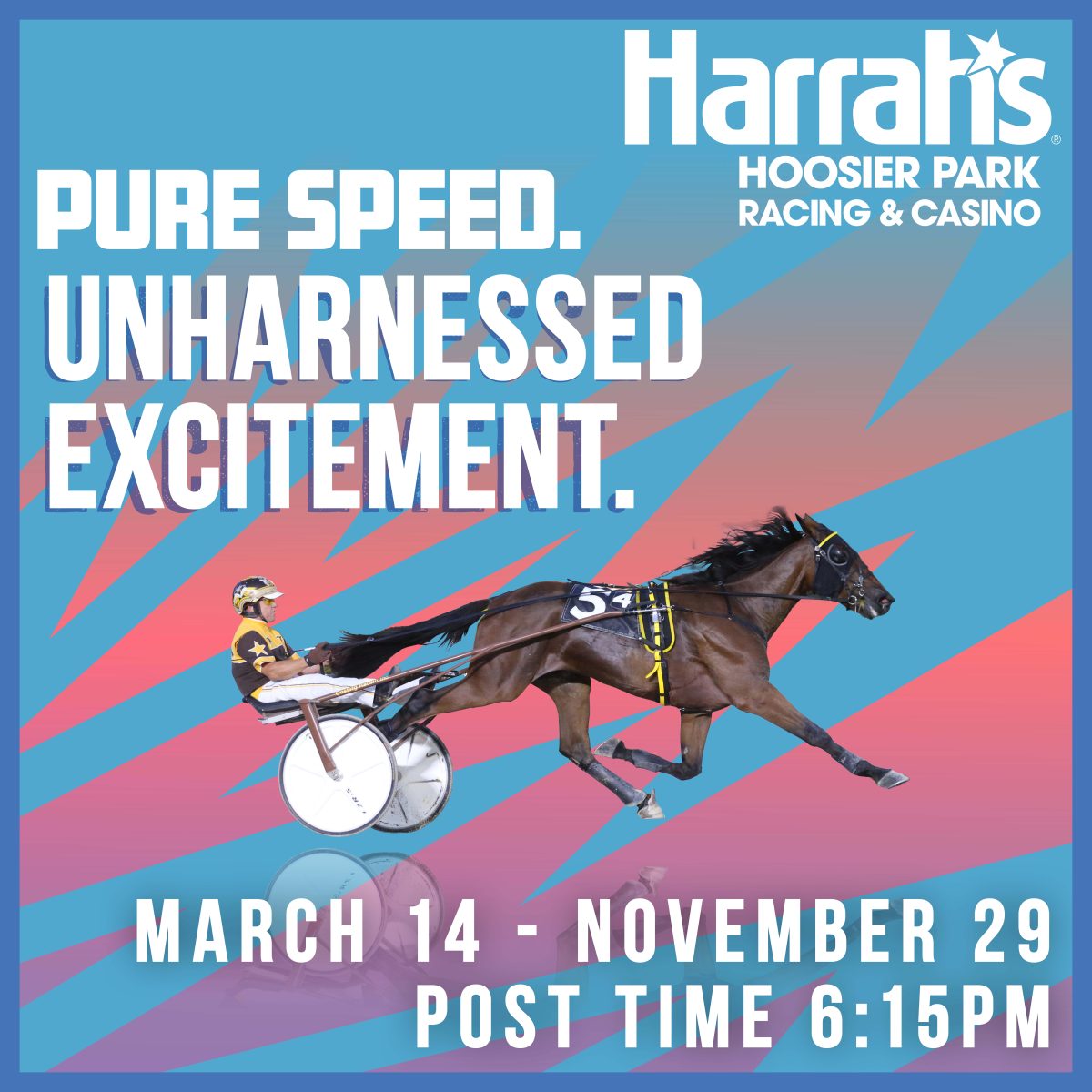Unwanted trotter A Blue Million streaking at Harrah’s Hoosier Park
by James Platz
A pedigree page can make or break a yearling before the young horse even enters the sales ring. If prospective buyers don’t see ample production, or observe bloodlines they don’t favor, a yearling is quickly passed over. Sophomore trotter A Blue Million suffered this fate as a yearling. The unwanted gelding went on to a successful fair season in 2023 and is now three-for-three at Harrah’s Hoosier Park, most recently scoring a 1:56.1 triumph in the second leg of The Cardinal series held April 10.
“He was a little bit small, but nobody would have known because nobody asked to have him out,” said his breeder, Roman Stoll. “He didn’t have bad conformation, but he wasn’t perfect either.”
Stoll consigned A Blue Million to the 2022 Hoosier Classic sale under the banner of his farm, Rollin Acres. The gelding is from the second crop of Swan In A Million, brother to Indiana’s perennial leading trotting sire, Swan For All. Swan In A Million’s first crop did not have a breakout debut. Strike one against the colt. His dam, Yankee Glide mare Ipo Blue Chip, had three previous foals with very little production. Strike two.
“I had a Pilgrim’s Chuckie filly that didn’t race, a Swan For All that had just started racing good and died, and a Helpisontheway colt that was training down good and had an injury,” said Stoll. “It looked like a dead-end road for the mare, so I sold her. Not the most promising page as far as production at the yearling sale.”
To make matters worse, A Blue Million was cataloged as Hip #410 in the two-day sale, selling next to last. On the second day of the Hoosier Classic desperation can set in for buyers, but even then, there were no interested parties coming to the aisle. Strike three.
“I had the best yearling sale I ever had with that crop of yearlings,” Stoll said of the 2022 consignment. “He was never asked to be out of the stall. Nobody wanted to see him. The thing with this trotter is that the pedigree is there. The mother had a 2-year-old record of 1:56. She made a quarter million. In all honesty, why not? But there were the two or three in front of this one that didn’t go, and you’ve got a Swan In A Million, so you’ve got a cheap colt.”
As the sale began to wind down, reality set in. Stoll’s son, Jeremy, admitted the painful truth.
“He told me, ‘Dad, nobody is going to buy that yearling,’” the breeder said. “I said, ‘I know, but we had a good sale, and we always sell ours. If you buy him, you’re on your own.’”
Jeremy purchased the gelding for $4,500, and his uncle Steve (Roman’s brother), bought in on the young trotter.
Entrusted to Leander Schwartz as a freshman, A Blue Million raced exclusively on the Indiana fair circuit. He made 17 starts throughout the summer and into the early fall. Driven primarily by Michael Detweiler, the trotter earned his first win at Kentland, coming in his seventh attempt. The only horse to not break stride in the race, A Blue Million won by just over 27 lengths. He would collect another win and qualify for the Governor’s Cup final in August, but made multiple breaks and finished sixth.
The freshman was plagued by breaks early in the season, but he finished strong in his final five starts of 2023. A Blue Million finished first or second in each of the attempts, registering three wins. He captured the second series final, held Oct. 7 at Frankfort, driven for the first time by fair circuit veteran Mike Peterson.
“I picked up the drive at Frankfort in the second championship in the fall,” said Peterson. “I won with him out of the 8-hole that day in 2:02.3, which is a huge mile. That was definitely impressive that day.”
Banking just under $15,000 racing on the fairs, A Blue Million fit the conditions for The Cardinal series (non-winners of 1 pari-mutuel race lifetime and under $20,000 in lifetime earnings). Before entering the series, the trotter qualified twice for Detweiler. The sophomore finished second in the initial effort, but closed out the mile with a :26.3 last quarter. He would win the second qualifier and his seasonal debut in the Donnie Conrad Memorial. With Peterson returning to the bike, the duo claimed victory by 7½- lengths in 1:55.4.
In the opening round of The Cardinal, held April 3, Peterson pushed his charge from fourth at the quarter to the lead before finishing a length and a quarter in front, stopping the clock in 1:58.1 over a good surface. Wednesday night (April 10) A Blue Million left the gate seventh in the field of eight before Peterson moved first up. The gelding advanced to second as the field reached three quarters over the rain-soaked and sloppy track. Splashing home in :26.4, favorite A Blue Million tripped the timer in 1:56.1, three parts of a length ahead of second choice Hudson Swan.
“It was hurricane conditions,” Peterson said of the performance. “It was a nasty, nasty night. He came first up and got home in :26.4. That was an impressive mile for a green horse. He’s just a nice horse. He acts like a good feeling horse. He’s got a good head on his shoulders. He likes to finish, but he does it both ways.”
Now perfect in three seasonal starts, the 3-year-old has earned $17,500 for his connections, and is among the favorites to capture the $20,000 final, slated for Wednesday (April 17). Peterson will steer the gelding from post 3 in the night’s 12th race. Roman is quick to put A Blue Million’s success in perspective, but he is also reminded of a similar scenario that played out in the past.
“I remind my son that you can’t expect this with every $4,500 yearling,” he said. “I’m thrilled. I had almost the identical thing happen 15 years ago with Dakota’s Final. I sold him for $2,500 and he made a quarter million and got me $12,000 in breeders awards.”
Dakota’s Final hit the board in 14 of 16 starts at 3, winning five times during the 2010 season and accumulating $225,913. Perhaps history can repeat itself once again.


















